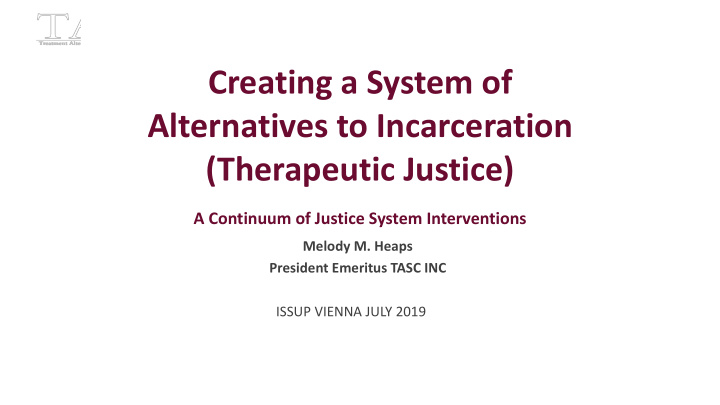



Creating ¡a ¡System ¡of ¡ Alternatives ¡to ¡Incarceration (Therapeutic ¡Justice) A ¡Continuum ¡of ¡Justice ¡System ¡Interventions Melody ¡M. ¡Heaps President ¡Emeritus ¡TASC ¡INC ISSUP ¡VIENNA ¡JULY ¡2019
Drugs ¡& ¡Crime: ¡A ¡Costly ¡Connection Alcohol ¡and ¡other ¡drugs ¡involved ¡in: ¡ • 78% ¡of ¡violent ¡crimes • 83% ¡of ¡property ¡crimes • 77% ¡of ¡public ¡order ¡immigration, ¡or ¡weapon ¡ offenses; ¡and ¡probation/parole ¡violations
Drugs ¡& ¡Crime: ¡A ¡Costly ¡Connection Illegal ¡drug ¡use ¡costs ¡U.S. ¡taxpayers ¡$193 ¡billion ¡per ¡year • Costs ¡associated ¡with ¡health ¡= ¡$11.4 ¡billion • Costs ¡associated ¡with ¡crime ¡= ¡$113.3 ¡billion ¡ • Costs ¡associated ¡with ¡lost ¡productivity ¡= ¡$68.4 ¡billion
We ¡know ¡that ¡substance ¡use ¡and ¡mental ¡illness ¡are ¡driving ¡ factors ¡in ¡justice-‑system ¡involvement—but ¡only ¡11% ¡of ¡ those ¡who ¡need ¡it ¡receive ¡treatment ¡in ¡prison ¡or ¡jail 68% 64% 56% 53% 19% 17% 16% 9% 4% GENERAL STATE PRISON GENERAL STATE PRISON LOCAL GENERAL STATE PRISON LOCAL LOCAL POPULATION POPULATION JAIL POPULATION JAIL JAIL ANY MENTAL HEALTH SERIOUS MENTAL ILLNESS SUBSTANCE USE DISORDER PROBLEM Sources: James and Glaze, 2006; Ditton, 1999 and Metzner, 1997 as cited in Osher, D’Amora, Plotkin, Jarrett, and Eggleston, 2012; Mumola and Karberg, 2006; Karberg and James, 2005; NSDUH at SAMHSA, 2013; National Center on Addiction and Substance Abuse at Columbia University
Revolving ¡door ¡of ¡justice ¡involvement • 9 ¡million ¡churn ¡through ¡jails ¡every ¡year • 730,000 ¡people ¡admitted ¡and ¡released ¡from ¡ prisons ¡each ¡year ¡ • Two-‑thirds ¡(68%) ¡of ¡prisoners ¡rearrested ¡ within ¡3 ¡years ¡of ¡release ¡ • Half ¡(52%) ¡of ¡prisoners ¡returned ¡to ¡prison ¡for ¡ new ¡crime ¡or ¡violation
Therapeutic ¡Justice ¡is ¡a ¡Process ¡and ¡Method ¡ which: I. Integrates ¡a ¡Public ¡Health ¡Approach ¡to ¡Addiction ¡into ¡the ¡ Criminal ¡Justice ¡System ¡ II. Provides ¡an ¡Opportunity ¡for ¡Treatment ¡Interventions ¡along ¡ the ¡Criminal ¡Justice ¡Continuum ¡from ¡Arrest ¡to ¡Community ¡ Release III. Connects ¡Evidence ¡Based ¡Addiction ¡Treatment ¡and ¡the ¡Justice ¡ System IV. Facilitates ¡Communication ¡between ¡and ¡among ¡Public ¡ Health/Treatment ¡Services ¡and ¡Justice ¡System
Integrating ¡Public ¡Health ¡and ¡Treatment The ¡earlier ¡people ¡are ¡diverted ¡out ¡of ¡the ¡justice ¡system ¡ and ¡into ¡treatment, ¡the ¡better ¡their ¡prospects ¡will ¡be. • As ¡few ¡as ¡3 ¡days ¡in ¡jail ¡can ¡significantly ¡increase ¡the ¡likelihood ¡of ¡ future ¡justice ¡involvement • Outcomes ¡for ¡justice-‑involved ¡individuals ¡who ¡receive ¡treatment ¡are ¡ significantly ¡better ¡than ¡for ¡those ¡who ¡do ¡not. ¡This ¡is ¡true ¡for ¡ interventions ¡across ¡the ¡justice ¡continuum. Match ¡interventions ¡to ¡individuals’ ¡risks ¡and ¡needs. ¡ • Empirical ¡evidence ¡demonstrates ¡that ¡recidivism ¡can ¡be ¡reduced ¡ through ¡applying ¡well-‑designed ¡programs ¡that ¡are ¡matched ¡to ¡ individuals’ ¡unique ¡risk ¡and ¡need ¡profiles
Proportionality • Balance ¡seriousness ¡of ¡offense ¡ and ¡severity ¡of ¡punishment • Minimum ¡level ¡needed ¡to ¡ protect ¡society • Suitable ¡type ¡of ¡supervision ¡and ¡treatment; ¡ reviewed, ¡adjusted ¡and ¡terminated ¡when ¡ appropriate • Responses ¡to ¡non-‑compliance ¡or ¡breaches ¡not ¡ automatically ¡custodial ¡in ¡nature
UNODC-‑WHO ¡Standards • 3.1 ¡Treatment ¡for ¡drug ¡use ¡disorders ¡should ¡be: ¡ – in ¡health ¡and ¡social ¡care ¡systems; – there ¡should ¡be ¡effective ¡coordination ¡with ¡the ¡criminal ¡justice ¡ system • 3.2 ¡Treatment ¡of ¡drug ¡use ¡disorders ¡should ¡be: – available ¡to ¡offenders ¡with ¡such ¡disorders; ¡ – where ¡appropriate, ¡be ¡a ¡partial ¡or ¡complete ¡alternative ¡to ¡ imprisonment ¡or ¡other ¡sanctions. ¡ • 3.3 ¡Treatment ¡of ¡drug ¡use ¡disorders ¡as ¡an ¡alternative ¡to ¡ incarceration ¡should ¡be ¡supported ¡by ¡appropriate ¡legal ¡ frameworks. ¡ Source: ¡UNODC-‑WHO ¡2016
UNODC-‑WHO ¡Standards • 3.4 ¡Criminal ¡justice ¡settings ¡should ¡provide ¡treatment ¡to ¡justice ¡involved ¡individuals ¡within ¡the ¡community. ¡ 3.5 ¡Treatment ¡interventions ¡for ¡drug ¡use ¡disorders ¡should ¡not ¡be ¡imposed ¡on ¡justice ¡involved ¡individuals ¡ • against ¡their ¡will. ¡ 3.6 ¡Prevention ¡and ¡treatment ¡services ¡should ¡be ¡accessible ¡to ¡justice ¡involved ¡individuals ¡with ¡drug ¡use ¡ • disorders ¡including: ¡ prevention ¡of ¡transmission ¡of ¡blood-‑borne ¡infections – pharmacological ¡treatment ¡ ¡ – psychosocial ¡treatment ¡ – treatment ¡of ¡comorbid ¡health ¡conditions ¡ – rehabilitation ¡services – linkages ¡with ¡community-‑based ¡services ¡prior ¡to ¡release ¡ – Source: ¡UNODC-‑WHO ¡2016
UNODC-‑WHO ¡Standards 3.7 ¡Appropriate ¡training ¡programmes for ¡criminal ¡justice ¡system ¡staff, ¡should ¡be ¡in ¡ • place ¡to ¡ensure ¡recognition ¡of ¡medical ¡and ¡psychosocial ¡needs ¡and ¡to ¡support ¡ treatment ¡and ¡rehabilitation ¡efforts. ¡ 3.8 ¡Treatment ¡of ¡drug ¡use ¡disorders ¡in ¡the ¡criminal ¡justice ¡system ¡should ¡follow: • – the ¡same ¡evidence-‑based ¡guidelines, ¡ – community-‑based ¡ethical ¡and ¡professional ¡standards 3.9 ¡Continuity ¡of ¡treatment ¡for ¡drug ¡use ¡disorders ¡should ¡be ¡ensured ¡in ¡all ¡cases ¡by ¡ • effective ¡coordination ¡between ¡health, ¡social ¡services, ¡and ¡criminal ¡justice. Source: ¡UNODC-‑WHO ¡2016
Opportunities ¡To ¡Intervene The ¡Criminal ¡Justice ¡System Pre-‑Arrest Post ¡Sentencing ¡Proceeding Criminal ¡Proceeding
Opportunities ¡for ¡Interventions ¡along ¡the ¡ ¡ ¡Criminal ¡Justice ¡ Continuum A. ¡Deflection LAW ¡ENFORCEMENT/POLICE ¡ No ¡Charge ¡filed/referral ¡to ¡treatment B. ¡Diversion LAW ¡ENFORCEMENT/PROSECUTOR Arrest ¡Charge ¡Pending ¡Referral ¡to ¡Treatment ¡and ¡successful ¡ completion C. ¡Sentencing ¡Alternatives COURT ¡JUDICIARY Order ¡Treatment ¡instead ¡of ¡jail ¡or ¡prison (TASC/ ¡Drug ¡Court ¡Model)
Opportunities ¡for ¡Interventions ¡along ¡the ¡criminal ¡justice ¡ continuum D. ¡Community ¡Supervision PROBATION/PAROLE Refer ¡to ¡Treatment ¡to ¡minimize ¡recidivism/in ¡lieu ¡of ¡violation E.Jail/Prison CORRECTIONS Treatment ¡provided ¡while ¡incarcerated ¡by ¡licensed/trained ¡counselors Treatment ¡provided ¡by ¡licensed ¡community ¡treatment ¡provider Pre ¡Release ¡Treatment ¡and ¡Case ¡Management ¡Planning F. ¡Re-‑entry PROBATION/PAROLE/LAW ¡ENFORCEMENT Referral ¡to ¡community ¡treatment ¡upon ¡release Continued ¡Treatment ¡Interventions ¡while ¡under ¡supervision ¡of ¡CJ ¡authority Treatment ¡Compliance ¡reporting ¡to ¡cj authority
Connecting ¡Public ¡ Health ¡System ¡with ¡ Justice ¡System: CASE ¡MANAGEMENT The ¡needs ¡of ¡the ¡justice ¡ population ¡are ¡complex, ¡ and ¡often ¡require ¡years ¡ to ¡address. ¡ In ¡the ¡U.S., ¡centralized ¡case ¡ management ¡can ¡help ¡justice-‑ involved ¡individuals ¡navigate ¡ myriad ¡public ¡systems ¡and ¡ intervention ¡programs. Source: Community Catalyst, 2016
Connecting ¡Public ¡Health ¡System ¡ with ¡Justice ¡System • Develop ¡treatment ¡and ¡social ¡rehabilitation ¡plan • Facilitate ¡connection ¡to ¡necessary ¡social ¡and ¡ primary ¡care ¡supports ¡as ¡needed • Provide ¡patient ¡support ¡through ¡treatment ¡and ¡ recovery ¡process
Recommend
More recommend